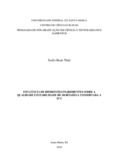| dc.creator | Thiel, Suslin Raatz | |
| dc.date.accessioned | 2018-09-12T13:11:48Z | |
| dc.date.available | 2018-09-12T13:11:48Z | |
| dc.date.issued | 2018-03-02 | |
| dc.identifier.uri | http://repositorio.ufsm.br/handle/1/14268 | |
| dc.description.abstract | Mortadella is one of the most consumed meat products in several countries, its consumption is
attributed due to its pleasant taste and low cost. Currently, with changes in Brazilian legislation,
industries find it difficult to achieve and maintain the determined value of 0,955 of water
activity of products sold at room temperature. Aiming to maintain water activity 0,955, the
objective of the present study was to evaluate the effects of different ingredients on water
activity and stability of mortadella stored at room temperature. In the preparation of mortadella
formulations, the experiment planning methodology was used, where the concentration of
maize starch (0, 2,5 and 5%) was varied; concentrated soy protein (0, 1 and 2%); powdered
milk (0, 1 and 2%) and crystal sugar (0, 1,5 and 3%). The results indicated that the four
ingredients significantly affected (p <0,05) the quality of the products. For moisture the
ingredients of soy protein and corn starch presented the greatest effects. For the water activity,
the ingredients milk powder and sugar presented greater effects. The results of emulsion
stability with heating, milk powder and corn starch presented a significant positive effect, since
for emulsion stability without heating the starch did not have the same effect. Losses due to
reheating and freezing, with addition of these ingredients there were lower losses, because the
ingredients have the capacity to bind the water in the food matrix. The addition of these
ingredients represents an alternative for the reduction of water activity with potential
application in mortadella marketed at room temperature. | eng |
| dc.language | por | por |
| dc.publisher | Universidade Federal de Santa Maria | por |
| dc.rights | Attribution-NonCommercial-NoDerivatives 4.0 International | * |
| dc.rights.uri | http://creativecommons.org/licenses/by-nc-nd/4.0/ | * |
| dc.subject | Planejamento fatorial | por |
| dc.subject | Produtos cárneos emulsionados | por |
| dc.subject | Ligação da água | por |
| dc.subject | Carboidratos | por |
| dc.subject | Proteínas | por |
| dc.subject | Sais | por |
| dc.subject | Factorial planning | eng |
| dc.subject | Emulsified meat products | eng |
| dc.subject | Water binding | eng |
| dc.subject | Carbohydrates | eng |
| dc.subject | Proteins | eng |
| dc.subject | Salts | eng |
| dc.title | Influência de diferentes ingredientes sobre a qualidade e estabilidade de mortadela conservada a 35°C | por |
| dc.title.alternative | Influence of different ingredients on the quality and stability of conserved mortadela 35°C | eng |
| dc.type | Dissertação | por |
| dc.description.resumo | A mortadela é um dos produtos cárneos mais consumidos em diversos países, seu consumo é
atribuído devido o seu sabor agradável e baixo custo. Atualmente, com mudanças na legislação
brasileira as indústrias encontram dificuldades para alcançar e manter o valor determinado de
0,955 de atividade de água dos produtos comercializados a temperatura ambiente. Visando
manter a atividade de água 0,955, o objetivo do presente estudo foi avaliar os efeitos de
diferentes ingredientes na atividade de água e estabilidade da mortadela armazenada a
temperatura ambiente. Na elaboração das formulações de mortadela empregou-se a
metodologia de planejamento de experimentos, onde variou-se a concentração de amido de
milho (0, 2,5 e 5%); proteína concentrada de soja (0, 1 e 2%); leite em pó (0, 1 e 2%) e açúcar
cristal (0, 1,5 e 3%). Os resultados indicaram que os quatro ingredientes afetaram
significativamente (p<0,05) a qualidade dos produtos. Para a umidade os ingredientes proteína
de soja e amido de milho apresentaram os maiores efeitos. Para a atividade de água os
ingredientes leite em pó e açúcar apresentaram maiores efeitos. Os resultados de estabilidade
de emulsão com aquecimento, o leite em pó e o amido de milho apresentaram um efeito positivo
significativo, já para estabilidade da emulsão sem aquecimento o amido não teve o mesmo
efeito. Perdas por reaquecimento e congelamento, com adição destes ingredientes houveram
menores perdas, devido os ingredientes terem a capacidade de ligar a água na matriz do
alimento. A adição destes ingredientes representa uma alternativa para a redução da atividade
de água com potencial aplicação em mortadelas comercializadas a temperatura ambiente. | por |
| dc.contributor.advisor1 | Dornelles, Rosa Cristina Prestes | |
| dc.contributor.advisor1Lattes | http://lattes.cnpq.br/5690285106629177 | por |
| dc.contributor.referee1 | Campagnol, Paulo Cezar Bastianello | |
| dc.contributor.referee1Lattes | http://lattes.cnpq.br/7821610349128835 | por |
| dc.contributor.referee2 | Valduga, Eunice | |
| dc.contributor.referee2Lattes | http://lattes.cnpq.br/6077078808261552 | por |
| dc.creator.Lattes | http://lattes.cnpq.br/9415627582377354 | por |
| dc.publisher.country | Brasil | por |
| dc.publisher.department | Ciência e Tecnologia dos Alimentos | por |
| dc.publisher.initials | UFSM | por |
| dc.publisher.program | Programa de Pós-Graduação em Ciência e Tecnologia dos Alimentos | por |
| dc.subject.cnpq | CNPQ::CIENCIAS AGRARIAS::CIENCIA E TECNOLOGIA DE ALIMENTOS | por |
| dc.publisher.unidade | Centro de Ciências Rurais | por |



